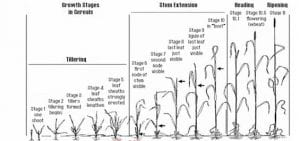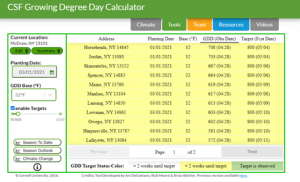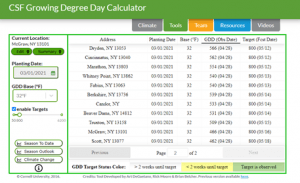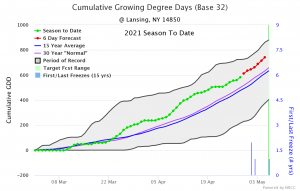Location Updates
As predicted, locations around the SCNY region gained around 100 GDD (B32) in the last week. The two images below show the cumulative Growing Degree Days (B32) for locations throughout the SCNY region. GDD are calculated using the Climate Smart Farming Growing Degree Day Calculator found at http://climatesmartfarming.org/tools/csf-growing-degree-day-calculator/
On average, locations climbed about 100 GDD since 4/23, with the range showing 73 – 116 GDD (B32). Locations highlighted in yellow (all locations in the first picture) are now approaching less than two weeks until our target of 800 GDD for cover crop harvest for dairy quality feed, with the earliest projected dates being 5/4. Pictured second are the locations receiving lesser amount of GDD, which may be further out for harvest. The moisture we received the last few days plus some heat will affect these dates as we move forward, and now is the time when we should starting looking at agronomic clues according to your location to help you determine when to harvest cover crop for dairy quality feed.
Determining Cover Crop Maturity Using Feeke’s
The picture below shows the stages from new plant through maturity for growth stages of cereals (Large, 1954). For our dairy quality feed, we are targeting harvest when most of the plants in the stand are at Stage 9. At Stage 9, the collar and ligule of the plant are visible. Flag leaf is the best indicator for the correct maturity to harvest cereal grain crops for dairy quality feed. If your location is approaching the targeted 800 GDD, now is the time to look at your fields to determine what stage your crop is in to determine when to harvest.
The NWNY Dairy, Livestock & Field Crops Team put together a short (~2min) video on how to determine what stage your cereal crop is in. It can be found at: https://youtu.be/NIk2X-tM84Q .
Further details on each stage of winter wheat and other winter cereal crops can be found in the great visual from UW Extension at: https://ipcm.wisc.edu/download/pubsGuides/UW_WheatGrowthStages.pdf
At harvest, tips to avoid fermentation failure in spring silages were shared via Hoard’s Dairyman earlier this week. Check out their article here. Tom Kilcer also shares information on Photosynthetic Drying in his May Newsletter. Open it at: Photosynthetic Drying May 2021_Kilcer
Looking at Lansing, NY
Looking more closely at Lansing again this week, as of 4/30 this location is sitting at 583 GDD, which fell short of its prediction to 640 and reminds us all to take predictions and GDD with a grain of salt. Projected GDD for the next week looks like 740 GDD by 5/4, which puts that location close to our target harvest around 800 GDD. In the next week, YOU SHOULD BE EVALUATING YOUR STANDS FOR RELATIVE STAGE OF MATURITY! \
Rye Cover Crop in McGraw, NY
My location continues to be on the lower side of gaining GDD, but even visually I’m seeing the plants work through the stages of maturity. We are strongly in stage 6 and some plants are working towards 7. Evaluating from the road isn’t enough – walk out into the stand and physically look at plants to determine where things are at.
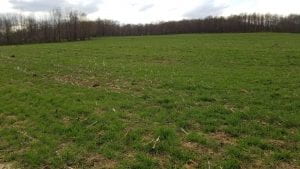
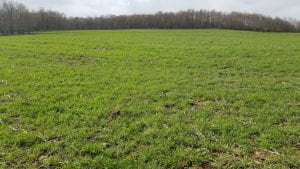
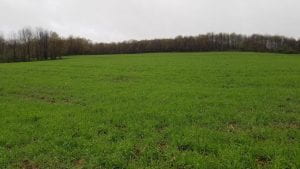
Alfalfa Field ID for First Cutting Updates
Our team of educators has identified nearly all the fields we will be including for our alfalfa height report. I want to again reiterate that you should evaluate your mixed stands to know the percent alfalfa in it, as many fields experienced winter kill. Evaluate your stands well before harvest to identify at which stage it should be harvested to capture peak quality! Dr Jerry Cherney at Cornell University has developed an app to help determine the percentage of alfalfa relative to grass. It can be found at: http://www.forages.org/index.php/tools-grassman
If you have fields to add to our list we check every Tuesday, please let me know – 607.391.2673 or bjh246@cornell.edu. Our first alfalfa height report will come out Wednesday May 5th.

